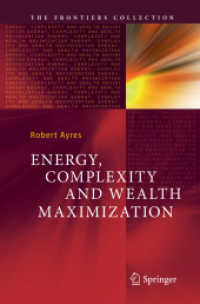- ホーム
- > 洋書
- > ドイツ書
- > Mathematics, Sciences & Technology
- > Technology
- > heat engineering, energy engineering, nuclear engineering
Full Description
This book describes results of research conducted with the goal of providing a framework, selected tools, and guidelines to significantly reduce energy use (by more than 50%) in government and public buildings. The scope of the book is limited to public buildings that were constructed before the 1980s with low internal loads (e.g., office buildings, dormitories, barracks, public housing, and educational buildings) and that were undergoing major renovation. The book contains description and analysis of 26 well-documented case studies from Europe (Austria, Denmark, Estonia, Germany, Ireland, Latvia, Montenegro, The Netherlands, and the UK) and the USA. After these data were collected, the case studies were analyzed with respect to energy use (before and after renovation), reasons for undertaking the renovation, co-benefits achieved, resulting cost-effectiveness, and the business models followed. Finally, "lessons learned" were compiled and compared.
Deep Energy Retrofit (DER) is a major building renovation project in which site energy use intensity (including plug loads) has been reduced by at least 50% from the pre-renovation baseline with a corresponding improvement in indoor environmental quality and comfort. Lessons learned from the case studies and experiences of the team clearly indicate that DER can be achieved with the application of "bundles" of a limited number of core technologies readily available on the market. Specific characteristics of some of these core technology bundles generally depend on the technologies available on an individual nation's market, on the minimum requirements of national standards, and on economics (as determined by a life cycle cost [LCC] analysis).
Contents
1. Project Summary and Analysis.- 1.1. Introduction.- 1.2. Climate Zones.- 1.3. Der Measure Bundles.- 1.4. Investment Costs.- 1.5. Impact of Der Measure Bundles.- 1.6. Decision Making Process.- 1.7. Financing and Business Models.- 1.8. Cost Effectiveness of Der.- 1.9. Lessons Learned.- 2. Conclusion.- References.- Appendix A: Case Study - Austria.- Appendix B: Case Study - Denmark.- Appendix C: Case Study - Estonia.- Appendix D: Case Study - Germany.- Appendix E: Case Study -Ireland.- Appendix F: Case Study - Latvia.- Appendix G: Case Studies - Montenegro .- Appendix H: Case Study - The Netherlands .- Appendix I: Case Study - United Kingdom.- Appendix J: Case Studies: United States.





